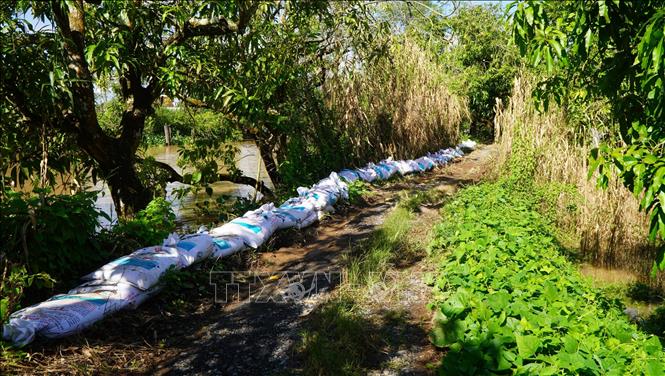
Faced with this situation, local authorities and people regularly check and reinforce weak dike sections, proactively respond to high tides, reduce the risk of flooding, and impact on life and production.
Mr. Dang Van Hung in Binh My B hamlet, My Hiep commune grows durian, guava and jackfruit on an area of over 8,000 m2. His garden is on Binh Thanh islet, located along the Tien River, so it is at risk of being flooded when the tide rises. Mr. Dang Van Hung said that in the past few days, he has been regularly checking the embankment, adding more soil to the embankment to make it about 0.2 m higher than the highest water level in 2024. Along with that, he has also prepared a pump to promptly pump out water when needed.
During the high tide, in the past few days, Mr. Huynh Van An in Khanh An hamlet, Tan Khanh Trung commune has also actively protected his garden of more than 3,000 square meters growing jackfruit and durian because these are plants sensitive to water. Mr. Huynh Van An said that currently, the water is high but there is a dike, so he is quite secure. However, he still has a pump "on standby" in the garden to be ready to pump out water when water leaks from outside the dike combined with rain to avoid flooding.
According to the People's Committee of Tan Khanh Trung commune (Dong Thap province), the locality is an agricultural commune, with a large fruit garden area of over 915 hectares, growing mango, longan, durian, jackfruit... The People's Committee of the commune identified the work of preventing and combating natural disasters, including high tides, as a key task, which needs to be proactively and synchronously implemented and mobilize the strength of the entire political system and the people to protect production safety, contributing to stabilizing life and developing the local economy.
The Commune People's Committee issues plans and assigns specific tasks to each specialized department, each hamlet, and the commune's socio-political organizations regarding the work of preventing and combating high tides. At the same time, direct the specialized department to coordinate with the heads of hamlets to monitor water level forecasts, inspect the actual dikes, culverts, canals, and intra-field canals; regularly review and update the boxes that are at risk of being unsafe or affected to have temporary reinforcement plans and propose the province to support funding for permanent repairs. The commune regularly broadcasts water level and high tide times on the loudspeaker system for people to know; propagates and mobilizes people to proactively respond to high tides, not to be subjective or negligent.
According to the assessment of the Dong Thap Hydrometeorological Station, the upstream water level will rise rapidly and reach its highest peak this year around October 10-12, at Hong Ngu station at about 3.5 m (approximately and higher than alarm level I). In the Thap Muoi inland area, the water level will peak around October 20-25 at alarm level II-III. The southwestern and downstream areas of Dong Thap province will reach the peak tide of the August Full Moon period on October 9-12, the water level will be 0.2-0.3 m higher than alarm level III. In general, the flood peak in 2025 in Dong Thap province will be 0.1-0.3 m higher than in 2024.
Weather developments continue to be complicated, storms, heavy rains combined with high tides increase the risk of widespread flooding, affecting people's lives and production. Especially in low-lying areas, along rivers, canals, and ditches; inland areas with embankments, and flood control systems are not yet reliable. To proactively respond and limit damage caused by floods combined with high tides, the People's Committee of Dong Thap province requires heads of provincial departments, branches, sectors, Chairmen of People's Committees of communes, wards and related units not to be negligent in natural disaster prevention and control work.
The Department of Agriculture and Environment closely monitors and coordinates with the Provincial Hydrometeorological Station, relevant agencies and units to update the direction of storm movement, heavy rain, rapid flood combined with high tides; organizes on-duty, seriously enhances the provision of timely forecast and warning bulletins to relevant localities and units to proactively direct, respond and inform people to proactively prevent. Along with that, strengthen inspection and assessment of the safety of the dyke system, irrigation works, and drainage serving agricultural production; guide localities to develop and implement plans to protect and respond to natural disasters in accordance with the actual situation of agricultural production areas, fruit tree production, and aquaculture in the province.
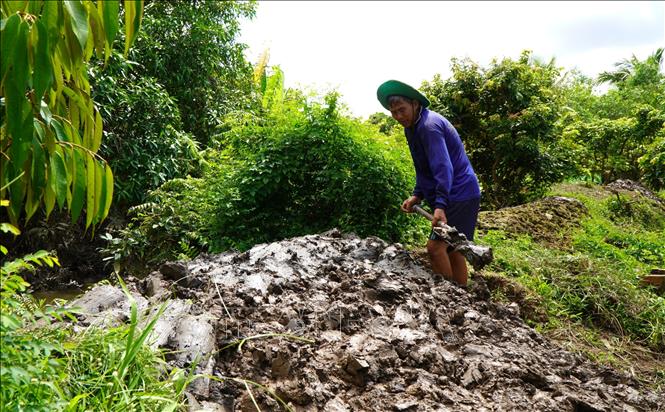
The Provincial People's Committee directs the People's Committees of communes and wards to closely monitor weather developments, proactively deploy solutions to promptly respond to situations and extreme developments of rain, floods and high tides, and risks of flooding and landslides every day from October 8 to 12; promptly update and fully inform forecasts and warnings on rain, floods and high tides so that agencies, units and people know and proactively prevent and respond, especially at peak tide times. Localities need to mobilize shock forces to organize inspections and identify vulnerable locations on dykes and embankments; organize regular patrols and guarding, and fully prepare materials and means such as Melaleuca stakes, earth bags, etc. to be ready to reinforce vulnerable locations.
Source: https://baotintuc.vn/kinh-te/dong-thap-gia-co-de-bao-xung-yeu-ung-pho-voi-trieu-cuong-dang-cao-20251009130515526.htm


![[Photo] General Secretary To Lam visits Kieng Sang Kindergarten and the classroom named after Uncle Ho](https://vphoto.vietnam.vn/thumb/1200x675/vietnam/resource/IMAGE/2025/10/09/1760023999336_vna-potal-tong-bi-thu-to-lam-tham-truong-mau-giao-kieng-sang-va-lop-hoc-mang-ten-bac-ho-8328675-277-jpg.webp)


![[Photo] Prime Minister Pham Minh Chinh chairs a meeting of the Government Standing Committee on overcoming the consequences of natural disasters after storm No. 11](https://vphoto.vietnam.vn/thumb/1200x675/vietnam/resource/IMAGE/2025/10/09/1759997894015_dsc-0591-jpg.webp)
![[Photo] President Luong Cuong attends the 80th Anniversary of the Traditional Day of Vietnamese Lawyers](https://vphoto.vietnam.vn/thumb/1200x675/vietnam/resource/IMAGE/2025/10/09/1760026998213_ndo_br_1-jpg.webp)





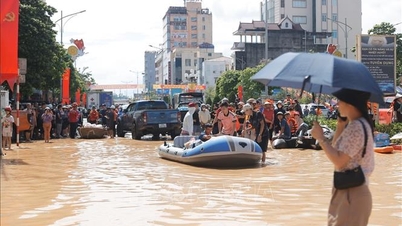
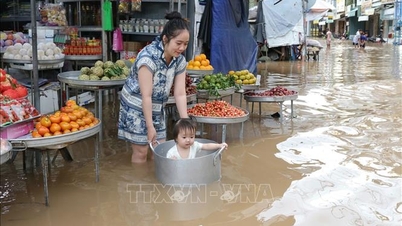
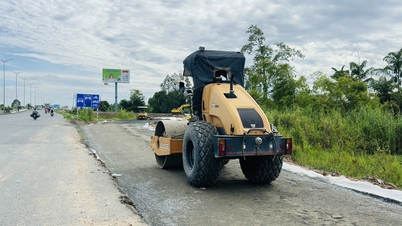



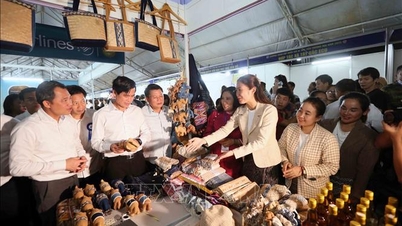



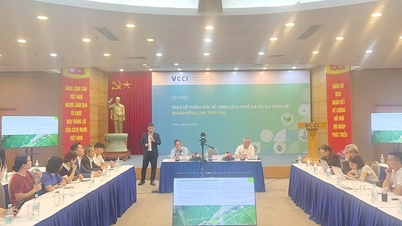













































































Comment (0)